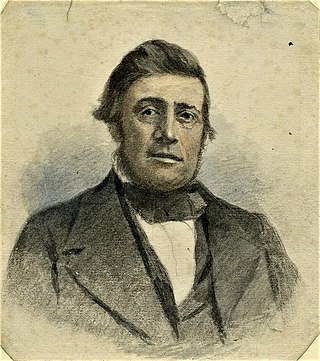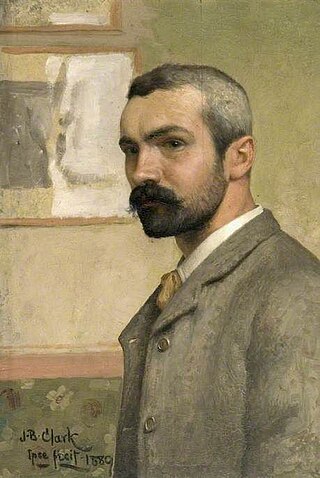Related Research Articles

Sir Francis Seymour Haden PPRE, was an English surgeon, better known as an original etcher who championed original printmaking. He was at the heart of the Etching Revival in Britain, and one of the founders of the Society of Painter-Etchers, now the Royal Society of Painter-Printmakers, as its first president. He was also a collector and scholar of Rembrandt's prints.

The etching revival was the re-emergence and invigoration of etching as an original form of printmaking during the period approximately from 1850 to 1930. The main centres were France, Britain and the United States, but other countries, such as the Netherlands, also participated. A strong collector's market developed, with the most sought-after artists achieving very high prices. This came to an abrupt end after the 1929 Wall Street crash wrecked what had become a very strong market among collectors, at a time when the typical style of the movement, still based on 19th-century developments, was becoming outdated.

Edmund Blampied was one of the most eminent artists to come from the Channel Islands, yet he received no formal training in art until he was 15 years old. He was noted mostly for his etchings and drypoints published at the height of the print boom in the 1920s during the etching revival, but was also a lithographer, caricaturist, cartoonist, book illustrator and artist in oils, watercolours, silhouettes and bronze.
Ernest Stephen Lumsden, was a distinguished painter, noted etcher and authority on etching.
Frederick Landseer Maur Griggs was an English etcher, architectural draughtsman, illustrator, and early conservationist, associated with the late flowering of the Arts and Crafts movement in the Cotswolds, centered in Chipping Campden. He was one of the first etchers to be elected to full membership of the Royal Academy, and was part of the final phase of the Etching Revival in Britain. He was elected the Master of the Art Workers' Guild in 1934.

The Royal Society of Painter-Printmakers (RE), known until 1991 as the Royal Society of Painter-Etchers and Engravers, is a leading art institution based in London, England. The Royal Society of Painter-Etchers, as it was originally styled, was a society of etchers established in London in 1880 and given a Royal Charter in 1888. Engraving was included within the scope of the Society from 1897, wood-engraving from 1920, coloured original prints from 1957, lithography from 1987 and all forms of creative forward-thinking original printmaking from 1990.
Events from the year 1655 in art.

George Worsley Adamson, RE, MCSD was a book illustrator, writer, and cartoonist, who held American and British dual citizenship from 1931.
John Nicolson was a British artist, etcher and illustrator for books and periodicals.

Edward Thomas Daniell was an English artist known for his etchings and the landscape paintings he made during an expedition to the Middle East, including Lycia, part of modern-day Turkey. He is associated with the Norwich School of painters, a group of artists connected by location and personal and professional relationships, who were mainly inspired by the Norfolk countryside.

Edmund Hort New was an English artist, member of the Birmingham Group, and leading illustrator of his day.

Nelly Erichsen was an English illustrator and painter. Born in Newcastle upon Tyne, she was born into a wealthy professional Danish family. After studies at the Royal Academy of Art in the 1880s, she pursued a successful career as an illustrator and writer, working with a number of publishing firms including J.M. Dent and Macmillan, and jointly publishing travel books with Janet Ross, a prominent member of the Anglo-Tuscan pre-War community. In July 2018 Nelly Erichsen - A Hidden Life, a biography of Erichsen by Sarah Harkness was published.
The Society of Graphic Art is a British arts organisation established in 1919.
Fine Prints of the Year was an annual series of books that reported and discussed the etchings, engravings, woodcuts and lithographs published each year between 1923 and 1938 by major artists of the period. All volumes reproduced in monochrome on high quality glossy paper a selection of about 100 limited edition prints published during the preceding year. The series provides an important record of the work of artists in the last years of the etching revival and during the collapse of the market for prints.
Geoffrey Heath Wedgwood, ARCA, RE was a British etcher and engraver, best known for his architectural etchings.
Winifred Maria Louise Austen was an English illustrator, painter, etcher and aquatint engraver, particularly known for her detailed depictions of small mammals and birds.

Thomas Lound was an amateur English painter and etcher of landscapes, who specialised in depictions of his home county of Norfolk. He was a member of the Norwich School of painters, and lived in the city of Norwich all his life.

Joseph Benwell Clark was an English painter, etcher, engraver in mezzotint and drypoint, and book illustrator.

David Strang was a British artist and printer, mainly of etchings and drypoints published in limited editions, for many well-known artists in the UK and USA in the 1920s and 1930s.
References
- ↑ Hopkinson, M (1999). No day without a line. A history of the Royal Society of Painter-Printmakers 1880–1999. Oxford: Ashmolean Museum.
- ↑ Who's Who in Art (1958), 9th edition. London: The Art Trade Press.
- ↑ Bender, J. H. (1939). The drypoints of S. Van Abbé. Print Collector's Quarterly 26/3, pp. 292–309.
- ↑ Salomon van Abbé, Art UK, accessed 4 February 2018